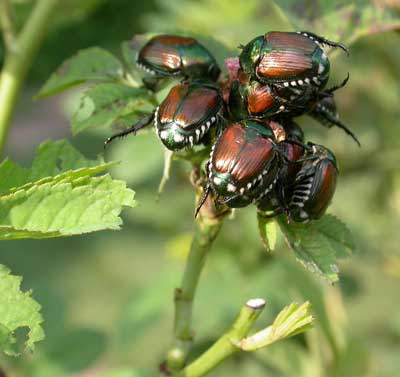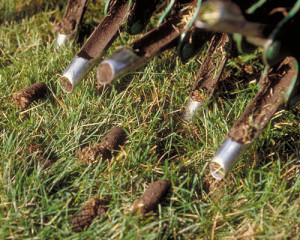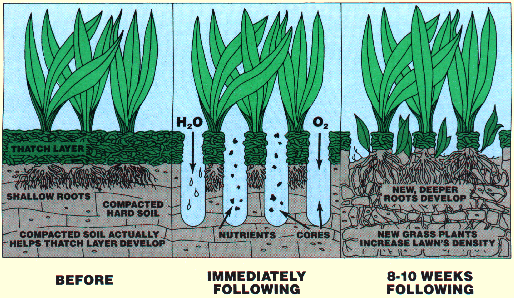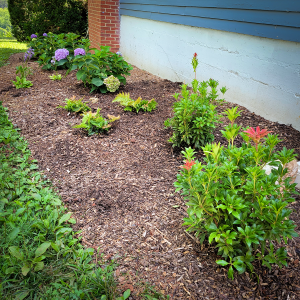We all liked to jump into large piles of leaves as children. However, now that we are homeowners we have the added responsibility of keeping our yards in check. Each fall, mother nature covers our lawn with leaves and there are a number of ways to deal with those fallen leaves. [Read more…]
Caring for Your Lawn After Aeration
We get a lot of questions from customers about how to get the most out of our aerating and overseeding services. Here are the best tips to maximize your investment and get the best-looking yard.
7 Tips for Watering New Lawns
Water – When…How…How Much
Water is essential to all life…too little water and we die, too much and we drown. The same is true of the grass in our lawns. Water makes up 70% to 80% of the weight of our lawn grasses and the clippings alone are nearly 90% water. While most people are concerned about not watering their lawns enough, the fact is that more lawns are damaged or destroyed by over-watering.
Newly installed turfgrass sod has very important watering needs. Proper watering immediately after installation will ensure the turf gets established, and it will also have an impact on how well the lawn continues to flourish for years to come. [Read more…]
Japanese Beetle

Japanese Beetle—just a pest? or causing serious damage?
The Japanese beetle is found throughout Virginia and has been well established in Virginia since the early 1970’s. They feed on a wide variety of trees, shrubs, and herbaceous plants. They can severely damage the foliage for fruit trees and grapes and can at times be pest of vegetables and field crops. The immature stage, also called a grub or white grub can reach pest status on many varieties of grass grown for turf in Virginia.
The adult of the Japanese beetle is bright metallic green and is about 3/8 inch long. It is smaller then the Green June beetle which is over ¾ inch long. The Japanese beetle wing covers are coppery colored and there are a series of tufts of white hairs on the abdomen. The larvae of the Japanese beetle are similar to other species of white grubs and have an off-white body with a brown head. They curl into a C-shape when not active. Japanese beetles larvae have a distinctive v-shaped row of spines on the end of the abdomen.
Damage from Adult Beetle: Japanese beetles chew small holes in leaves between the leaf veins. This damage gives the leaves a lacy appearance and is called skeletonizing. They will also feed on fruit and buds. Heavily damaged trees and plants will take on a brownish cast as leaves shrivel and die
Why Aerate Your Lawn?

Why Aerate Your Lawn?
Lawn aeration involves the removal of small soil plugs, or cores, out of the lawn. Typically, this process takes place in late August and throughout September. On many occasions, your lawn can be aerate/over-seed even later in the year provided the soil temperature stays high enough to get your new seed to germinate. There are numerous reasons to aerate your lawn. Here are some of the benefits of aerating:
• Aerating reduces your dependency on water. Why spend more money watering your lawn than you have to? In neighborhoods or cities where water is very expensive, nearly everyone will aerate their lawn. The aeration process allows water to get into the soil before the water has a chance to run off.
• Aerating reduces compaction. Over time, your lawn becomes compacted. Whether it is from you walking on your lawn, your children playing on the lawn or just general use, the soil becomes compacted. Soil that is compacted cannot absorb water, air, nutrients, seed, etc. that it desparately needs to stay healthy.
• Aerating encourages your roots to grow deeper. Within two weeks of aerating, you’ll notice that the holes left by the aerator start to fill up with plant roots or from the new seed that is normally used during the over-seeding process in the fall of the year.
 • Aerating holes help to absorb water. Rather than water having to start penetrating from the surface, it can start penetrating from one to 2 ½ inches below the surface. Not only will the holes made by the aerator hold the water, but they will also help the water to sink 2 – 4 inches deeper into the soil.
• Aerating holes help to absorb water. Rather than water having to start penetrating from the surface, it can start penetrating from one to 2 ½ inches below the surface. Not only will the holes made by the aerator hold the water, but they will also help the water to sink 2 – 4 inches deeper into the soil.
• It encourages thicker turf. As your roots grow down, your grass will grow quicker and also thicker, creating a thicker turf.
• Aerating helps build organic material in the soil. Compacted soil just doesn’t have nearly as much organic material in it. The aeration process allows organic material and other nutrients to enter the soil.
Let Dos Amigos Landscaping aerate your lawn this fall, for a beautiful green healthy lawn next spring! Call us to schedule: 434-465-0075


